| |
 |
Phnom Kulen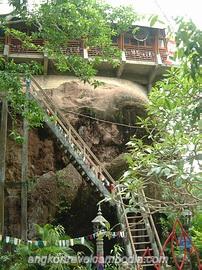
Phnum Kulen is considered by Khmer to be the most sacred mountain
in Cambodia and festivals. It played a significant role in the
history of the Khmer empire, as it was from here in 802 that Jayavaraman
II proclaimed independence from Jaya, giving birth to modern-day
Cambodia.
There is a small wat at the summit of the mountain, which houses
a large reclining Buddha carved into the sandstone boulder upon
which it is build. Nearby is a large waterfall and above it are
smaller bathing areas and a number of carvings in the riverbed,
including numerous lingas.
The bad news is that the private businessman bulldozed a road
up here in 1999 and now charges USD toll per foreign visitor,
an outrageous fee compared with what you get your money at Angkor.
None of the toll goes towards preserving the site.
The new road its way though some spectacular jungle scenery, emerging
on the plateau after a 45 minute ascent. The road eventually splits,
the left fork leading to the picnic spot, waterfalls and ruins
of a 9th century temple, the right fork continuing over a bridge
and some riverbed carvings to the reclining Buddha. This is the
focal point of a pilgrimage here for Khmer people, so it is important
to take off your shoes and any head coverings before climbing
the stairs to the sanctuary. The views from the 487 m peak are
tremendous, as you can see right across the forested plateau.
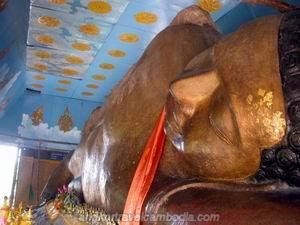
The waterfall is an attractive spot, but could be much more beautiful
were it not for the litter left here by families picnicking at
the weekend. You can cool off here if you like and, if you had
a bit of time to kill, it’s worthwhile clearing up some of the
mess and burning it.
If people can be shown how much more pristine the area is without
their leftovers then they might start disposing of things better
themselves, Near the waterfall is a jungle –clad temple known
as Prasat Romeas, dating from the 9th century-but explore it with
care. There are plenty of other Angkorian sites on Phnom Kulen,
including as many as 20 minor temples around the plateau, the
most important of which is Prasat Rong Chen, the first pyramid
or temple mountain to be constructed in the Angkor Area. 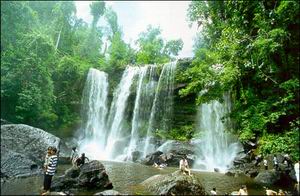
Most impressive of all are the giant stone animal of guardians
of the mountain, known as Sra Damrei (Elephant Pond). These are
very difficult to get to, the route passing through of the mountain
and the trail impossible in the wet season. The few who make it,
however, are rewarded with a life-size replica of a stone elephant,
a full4m long and 3m tall and smaller statues of lions, a frog
and a cow
These were constructed on the southern face of the mountain and
from here there are spectacular views across the pains mountain
below. Getting here requires taking a motor from Wat Pre Ang Thom
for about one hour on very rough trails through thick forest before
arriving at a sheer rock face. From here it is 20 minute walk
to the animals through the forest. 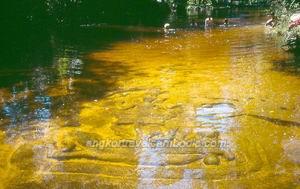
Phnom Kulen Mountain is a huge plateau around 50 km from Siem
Reap and about 15 km from Banteay Srei. To get here on the new
toll road, take the well-signposted right fork just before Banteay
Srei village and follow this, going straight ahead at the crossroads.
Just before the road start to climb the mountain, there is a barrier.
To walk to the site, head east along the base of the mountain
instead of going straight ahead at the major crossroads after
the right fork. After about 15km, there is a wat-style gate on
the left and a sandy trail. Follow this to a small community from
where the climb begins. It is about a 30 minute climb, including
a new staircase up the final cliffs, and then an hour or more
in a westerly direction along the top of the plateau. This rout
of the pilgrims of old should cost northing, although it takes
consideration longer.
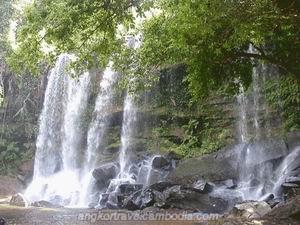
Back To The Top
|
 |